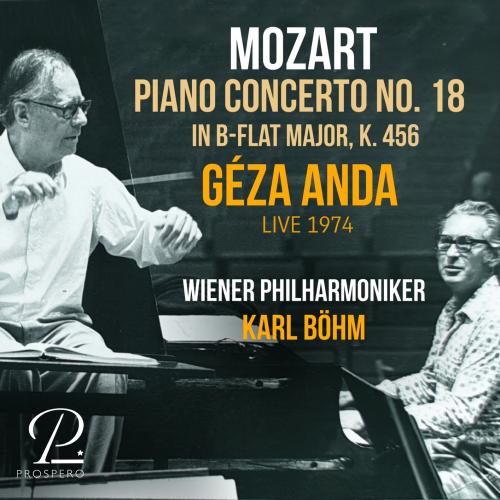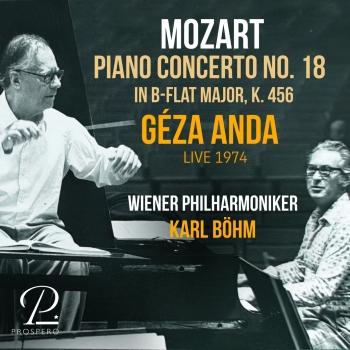
Mozart: Piano Concerto No. 18 in B-Flat Major, K. 456 (Live at the Salzburg Festival, 1974) (Remastered) (Live at the Salzburg Festival, 1974) Géza Anda & Vienna Philharmonic & Karl Böhm
Album info
Album-Release:
2024
HRA-Release:
26.04.2024
Label: Prospero Classical
Genre: Classical
Subgenre: Concertos
Artist: Géza Anda & Vienna Philharmonic & Karl Böhm
Composer: Wolfgang Amadeus Mozart (1756-1791)
Album including Album cover
- Wolfgang Amadeus Mozart (1756 - 1791): Original Austrian Radio Announcement (Live at the Salzburg Festival, 1974)
- 1 Mozart: Original Austrian Radio Announcement (Live at the Salzburg Festival, 1974) 02:29
- Piano Concerto No. 18 in B-Flat Major, K. 456:
- 2 Mozart: Piano Concerto No. 18 in B-Flat Major, K. 456: I. Allegro vivace (Live at the Salzburg Festival, 1974) 12:40
- 3 Mozart: Piano Concerto No. 18 in B-Flat Major, K. 456: II. Andante un poco sostenuto (Live at the Salzburg Festival, 1974) 12:07
- 4 Mozart: Piano Concerto No. 18 in B-Flat Major, K. 456: III. Allegro vivace (Live at the Salzburg Festival, 1974) 08:01
Info for Mozart: Piano Concerto No. 18 in B-Flat Major, K. 456 (Live at the Salzburg Festival, 1974) (Remastered) (Live at the Salzburg Festival, 1974)
"Bravo Mozart!" exclaimed Emperor Joseph II as he stood up and tipped his hat at the end of the first performance of Piano Concerto No. 18 KV 456 , played by Mozart himself on 30 September 1784.
For years, historical speculation was that Mozart had written this concerto for Maria Theresia von Paradis, based on a letter written around that time by Leopold Mozart to his daughter Nannerl. However, Hermann Ullrich has discounted this theory, based on the date of entry in Mozart's catalogue and the fact that von Paradis had left Paris at the start of October 1784, which indicated that there was not sufficient time to send her the concerto for performance. Richard Maunder has countered with the idea that Mozart could still have sent the concerto to Paris and that it would have been forwarded to von Paradis in London, where it was possible that she performed the work in March 1785.
Géza Anda, piano
Vienna Philharmonic
Karl Böhm, conductor
Digitally remastered
Géza Anda
was admitted to the famous Liszt Academy in Budapest at the age of merely thirteen and trained by its legendary professors. A scholarship enabled him to continue his studies in Berlin. During the Second World War, Anda managed to emigrate to Switzerland, and from then on made this country his home. His career, however, took him across all of Europe and on frequent tours to America, Asia and South Africa. He performed with all the great conductors from Fricsay and Karajan to Abbado and Boulez.
Born in Budapest on November 19, 1921, Géza Anda studied with Ernst von Dohnányi, Leó Weiner and Zoltan Kodály at the Liszt Academy of Music. In 1940 he won the famous Liszt Prize. About one year later he gave his Budapest concerto debut with the Second Piano Concerto by Brahms under Willem Mengelberg.
Anda was given a state scholarship that took him to Berlin. He made his debut with the Berlin Philharmonic under Wilhelm Furtwängler, who dubbed him “the troubador of the piano”. In Berlin – aged 20 – he also began to teach the piano and make his first recordings.
In 1943 he moved to Switzerland, and after some years in Geneva settled in Zurich. But his international career took Géza Anda not only across all of Europe. From 1955 onwards, he embarked on a total of 17 US tours, in addition to playing in Canada, Asia and South Africa.
Anda’s early bravura is displayed in the Liszt, Franck, Tchaikovsky and Rachmaninoff repertoire, his pioneering Bartók interpretations, and his brilliantly captivating Chopin – all filled with the same power of expression that distinguishes his performances of the German Classics and Romantics. His musical, technical and spiritual insights were based on an understanding of a work of music as a forging of form and substance, as evident in Beethoven as in Schubert, Schumann and Brahms. It was this approach that gave Anda’s playing its renowned clarity; it lay at the heart of his “festive temperament”.
Thanks to Clara Haskil’s encouragement, it also influenced his approach to Mozart.
From 1952 until his death, Anda made a solo appearance every year at the Salzburg Festival – a record matched by no other concert artist in Mozart’s birthplace.
In Salzburg, he started his collaboration with the Camerata Academica: he directed Mozart concertos from the keyboard, and took the orchestra on tour. With the same group he became the first artist to record all Mozart’s piano concertos, an achievement that brought about numerous awards. For 16 of these concertos, Anda wrote his own cadenzas, which have been published by Bote & Bock (Berlin and Wiesbaden, 1973).
Anda accepted teaching engagements throughout his career. From 1953 to 1955 he gave masterclasses at the International Summer Academy of the Mozarteum in Salzburg; in 1960 he succeeded Edwin Fischer as director of the Lucerne Masterclasses for ten years. From 1969 onwards, he continued this type of work at the International Masterclasses Zurich.
Géza Anda died in Zurich on June 13, 1976. Three years later, the first Concours Géza Anda – founded by his widow Hortense Anda-Bührle – was carried out with the aim of encouraging a younger generation of pianists to develop their musicianship in Anda’s spirit.
Géza Anda’s repertoire reflects the broad variety of his audience. What people heard was a style of playing that made them feel the human core of all great music.
It is now clear that the obligations imposed by our profession are immeasurable. To meet them, it needs the whole man. It needs love, intuition and an analytical mind. This love is a necessity, because – as Augustine says – “we only know as much as we love”. So, love is the first step towards knowledge. Intuition, because we need to have an eye for secrets that are not notated, and an analytical mind so that we can grasp the smallest parts and order them in the right relationship to the whole. These abilities can now allow us to unravel the musical score. Everything is contained within it. To seek the music behind the notes – as the platitude goes – is nonsense. The music is in the notes. When one note is joined by a second, then the music begins, and our work with it. None of these abilities can be separated from each other. Our main problems are just as inseparable. In other words, musical problems are technical problems about conjuring up the musical structure and the inner content of a work at the piano – and technical problems are musical problems, because the only raison d’être of the instrument is to make music. If anyone here misses the concept of “feeling”, it is absent on purpose. The individual ego is of the greatest personal importance, but not in relation to the work to be interpreted. The work has laid down its own emotional and atmospheric content in the musical text, and it is our task to extract it, not to put our own stamp on it, depending on our own moods. To be an interpreter, you cannot “learn” a work; you have to become completely one with it. You should embrace and absorb the work like a scorpion does its victim, so that there is no longer any difference between you in your rhythm of life, your breathing and feeling. The act of identification should be so complete that you no longer “play” or “reproduce” the work, but give birth to it anew every evening from within. (Géza Anda)
This album contains no booklet.










